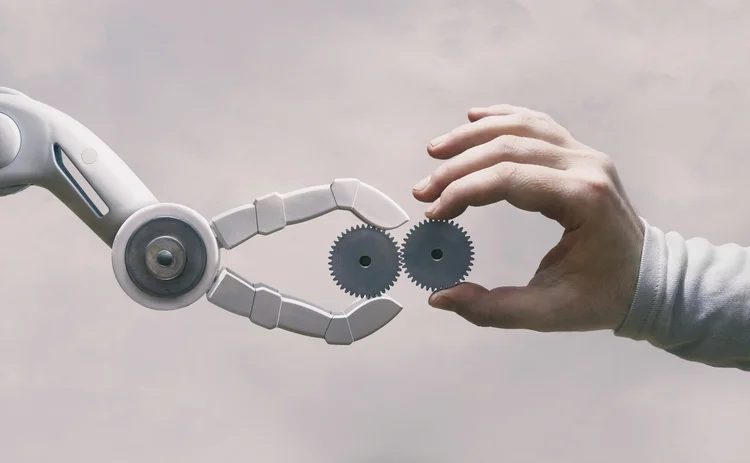Interoperability is not AI
Dan Schleifer, co-founder of Interop.io, explains how desktop interoperability underpins new AI developments.

Artificial intelligence—including generative AI and large language models (LLMs)—is the hottest topic in technology right now. Understandably, every tech company out there is trying to paint itself with an AI brush, for start-ups to fundraise off of, for enterprise software vendors to get client budget allocations, and so forth. Digital transformation is so 2022. This is the year when everything has to be AI.
But interoperability is not AI.
Desktop interoperability is the ability to integrate applications (of any kind) into streamlined workflows. Automation is a use case we see often, but what we do is not AI. At our recent annual client conference, we saw client after client present their interop.io implementations to their peers. The recurring theme was AI. But why is that so if interop is not AI? Because interoperability is the technology that connects AI to the applications where work gets done.
Chat in a box
Today’s dominant user experience for AI is chat—ask natural language questions and get a natural language reply (hopefully hallucination-free!). This chatbot approach feels natural to users. It’s conversational. It’s the way we interact with old-fashioned intelligence.
As an example, one of our clients in wealth management has built an AI “coach” that a wealth manager can ask just about anything: “Which of my clients over $500,000 in assets have any related exposure to today’s oil price jump?” Ta-da! Here’s a list of clients who have exposure to oil futures or ETFs, energy sector companies, and companies that use a lot of oil. “Do our analysts think that it’s temporary or that the price will go back down?” Bingo! Here’s a summary of the latest research report from the energy desk.
Interoperability is the technology that connects AI to the applications where work gets done
It’s pretty amazing stuff. But what happens next? The wealth manager needs to search for each client in the list. Then, pull them open in the customer relationship management (CRM) system. Then, pull up their portfolio in a separate application. Then, draft an email letting them know which assets they have with exposure. Then, copy and paste the relevant bits of the research summary. Then, send the email and record it in the CRM. Rinse and repeat for every single client on the list.
Interop: the last mile for AI
This is where interoperability steps in. Interop does the busy work for the wealth manager—looking up each client’s portfolio, drafting an email (using AI!) with the exposure and research information, logging the email into CRM, and so on.
All the wealth manager needs to do is skim each email, make any tweaks they want, and hit send. The rest is orchestrated by interop.
Interop connects AI to the applications where the real work gets done. This harnesses the power of AI through customized, streamlined workflows. Now, the wealth manager can focus their time on actual client engagement rather than on searching, clicking, typing, copying and pasting, and recording activities in the CRM.
Low-code, interop-enabled application development using LLMs
Another AI use case we saw at our client conference was allowing users to chat with an AI and asking it to build applications. You’ve probably seen videos like this floating around the internet—someone describes a basic app or game, and the AI writes the code and builds the application. With our clients, we’re seeing real-world adoption of this approach applied to complex capital markets problems.
AI is revolutionary, but in the end, it’s just one more technology that can’t live in a silo (or chat window)
A massive, multi-strategy hedge fund showed how a portfolio manager could ask the chatbot a question about their own P&L. The LLM understands the portfolio, performance, and risk information stored in their backend systems. It also respects data entitlements to ensure the portfolio manager only gets answers based on data they’re permissioned for.
But instead of simply answering the question with text, the LLM analyzes the question, analyzes the responsive data, and on the fly, builds multiple brand new data visualization apps—based on a library of atomic user interface components the LLM is trained on—to answer the question with data.
The portfolio manager can select the visualization components they like and pop them out as interop-enabled components on their smart desktop. The components update in real-time, and because of interop, link, sync, and interact with the other applications on the portfolio manager’s desktop like their market data terminal, order management system, and so forth.
What would have been a lengthy (and expensive!) exercise in tracking down a developer, walking them through the question and the underlying data, having the developer make several attempts to build analytics to answer the question, and then deploying the component into production, now takes less than a minute.
AI and interoperability
Interop has always been about connecting new and old, providing an integration fabric to connect disparate applications, and enabling plug-and-play such that old apps can be replaced by new ones without disrupting users’ workflows. AI is revolutionary, but in the end, it’s just one more technology that can’t live in a silo (or chat window).
Dan Schleifer is president and co-founder of Interop.io. In 2012, he co-founded ChartIQ (now owned by S&P Global), and in 2017, he co-founded Finsemble, which merged with Glue42 last year to form Interop.io.
Only users who have a paid subscription or are part of a corporate subscription are able to print or copy content.
To access these options, along with all other subscription benefits, please contact info@waterstechnology.com or view our subscription options here: https://subscriptions.waterstechnology.com/subscribe
You are currently unable to print this content. Please contact info@waterstechnology.com to find out more.
You are currently unable to copy this content. Please contact info@waterstechnology.com to find out more.
Copyright Infopro Digital Limited. All rights reserved.
As outlined in our terms and conditions, https://www.infopro-digital.com/terms-and-conditions/subscriptions/ (point 2.4), printing is limited to a single copy.
If you would like to purchase additional rights please email info@waterstechnology.com
Copyright Infopro Digital Limited. All rights reserved.
You may share this content using our article tools. As outlined in our terms and conditions, https://www.infopro-digital.com/terms-and-conditions/subscriptions/ (clause 2.4), an Authorised User may only make one copy of the materials for their own personal use. You must also comply with the restrictions in clause 2.5.
If you would like to purchase additional rights please email info@waterstechnology.com
More on Emerging Technologies
As trading firms embrace AI, so do hackers
According to a Google cybersecurity report, cybercriminals are turning to AI to sharpen their attacks.
AI & data enablement: A looming reality or pipe dream?
Waters Wrap: The promise of AI and agents is massive, and real-world success stories are trickling out. But Anthony notes that firms still need to be hyper-focused on getting the data foundation correct before adding layers.
Waters Wavelength Ep. 343: Broadridge’s Jason Birmingham
This week, Jason Birmingham of Broadridge talks with Tony about the importance of fundamentals as technology rapidly evolves.
Data standardization is the ‘trust accelerator’ for broader AI adoption
In this guest column, data product managers at Fitch Solutions explain AI’s impact on credit and investment risk management.
BNY inks AI deal with Google, Broadridge moves proxy voting to AWS, Expero delivers ICE market data, and more
The Waters Cooler: TSX Venture Exchange data hits the blockchain, SmartTrade acquires Kace, and garage doors link to cloud costs in this week’s news roundup.
Everyone wants to tokenize the assets. What about the data?
The IMD Wrap: With exchanges moving market data on-chain, Wei-Shen believes there’s a need to standardize licensing agreements.
Google, CME say they’ve proved cloud can support HFT—now what?
After demonstrating in September that ultra-low-latency trading can be facilitated in the cloud, the exchange and tech giant are hoping to see barriers to entry come down.
Waters Wavelength Ep. 342: LexisNexis Risk Solutions’ Sophie Lagouanelle
This week, Sophie Lagouanelle, chief product officer for financial crime compliance at LNRS, joins the podcast to discuss trends in the space moving into 2026.






